Hello,
Welcome to today’s edition of Kitchen Projects, my recipe development journal. Thank you so much for being here.
Today we are jumping deep into my new favourite lent tradition: SEMLA. It’s the much loved Swedish soft bun of dreams filled with the most delicious almond paste.
Over on KP+ it’s an absolute classic just in time for Pancake Day: Crêpes by the wonderful Claire Dinhut! Its one of those forever recipes, if you know what I mean. Click here to read it!
What’s KP+? Well, it’s the level up version of this newsletter.By joining KP+, you will support the writing and research that goes into the newsletter and get access to extra content, community chat threads, and more. Subscribing is easy and only costs £5 per month. Why not give it a go?
Love,
Nicola
PS. Btw, whilst I continue to chip away at a major project, the free Sunday newsletter may be intermittent. KP+ will continue as usual!
A Very Fat Tuesday
This coming Tuesday, households across the UK are readying themselves. Forearm strength will be tested, and agility challenged. This can mean only one thing: It’s pancake day.
Always falling 47 days before Easter Sunday, Pancake Day (or Shrove Tuesday as it’s officially known) is the official feast day before lent. So the tradition goes, pancakes were an effective way to clear out your pantry of sinfully perishable eggs and fat ahead of the 40 days of devout fasting.
Whilst lent is no longer a strict fast for most practising Christians, the tradition remains. It’s one I feel very affectionate about Pancake Day. Both the name and the race (the most famous of which takes place in Olney and has a 570-year history) are straight out of a Richard Curtis film. But this year, I’m setting my sights further afield.
Shrove Tuesday is celebrated widely across the world and the celebrations vary. In many countries, it’s known as Fat Tuesday aka ‘Mardi Gras’. Among the plethora of events, there’s huge parade in New Orleans that has been taking place since 1827, an entire carnival in Rio de Janeiro, and masquerade balls in Venice. But in Sweden, a country clearly after my own heart, they eat buns. Lots and lots of buns. And not just any old buns, I’m talking about the glorious joy that is semla (singular) / semlor (plural).
I really do mean lots of buns. It’s estimated that some 6 million semlor are consumed in Sweden on Fat Tuesday. In the run-up to Easter, the total number sold is around 40 million. With a population of just 10 million, that puts into perspective just how popular this bun is.
If you aren’t already familiar with its form, it’s is a soft cardamom-scented bun filled with almond paste, topped with cream and dusted with icing sugar. Admittedly it’s a bit more involved than a pancake… but I promise you, it’s worth it. Traditionally semla (I think before all the bells and whistles of the modern version) was served in a bowl of hot milk, known as hetvägg, which I haven’t tried but looks very cosy.
On KP+ this week
Over on KP+, I’ve got you covered for the pancake side of fat tuesday. I’m SO delighted that the wonderful Claire Dinhut aka Condiment Claire is sharing her recipe for classic crêpe. It’s the kind of recipe that ends all recipes - you know, the kind that you’ll take with you forever and you’ll never have to look for another crêpe recipe again. Trust me.
Seeking semla
Before I started my development for this week’s recipe, I decided to check in with an expert in the field. Meet Csaba Osvath. Csaba is the head baker at Stora Bageriet in Stockholm. Before joining Stora he spent several years at the now-closed Petrus, also in Stockholm. With several Fat Tuesdays under his belt as a head baker, I knew he’d be able to point me in the right direction of a dream Semla.
I first met Csaba at Little Bread Pedlar - we worked together back in 2016/17, and, having worked alongside him, I’m not at all surprised that the semla from his bakery regularly wins the title of the best in Stockholm! He really is such a talented baker. Csaba has generously lead the way for today’s newsletter and answered my questions about the famous buns and his process at Stora as well as a bit of the history (and scale) of the day!
What’s it like in the run-up to fat Tuesday at the bakery? When do you start making semlor?
Csaba: So many bakeries start making semlor right after the new year, straight from the first week of January. It used to be the opposite - the tradition was to only eat on Fat Tuesday, “fettisdagen" and until Easter. At my bakery, we started on the 3rd week of January. We wanted to wait - other bakeries were putting their prices up and hyping everyone up! My bakery won the competition last year with a different taste and now with my new mandelmassa (almond paste) filling, we won this year’s competition too in Stockholm. (You can check out the article here)
In terms of numbers, we are slowly increasing! Stora is quite new in Stockholm - only 2 years old - so on weekdays we make around 60-80 semlor and on the weekends 180-200! Other bakeries sell a lot more - there’s a bakery called Lillebros, also in Stockholm, who sell 700 weekdays and 1500-2000 at the weekend! They have an army basically, 2 people doing only semla each day in rotation.
On Tuesday we hope to sell around 1000 semlor at our shops. We have 3 sister cafes to deliver to - they will have a couple of hundred each.
Can you describe the perfect semla? What is the perfect ratio between bread, cream, almonds etc?
Csaba: I’ve spoken to lots of Swedes and everyone said the same. You must have cardamon in the bun, with almond filling and lightly whipped cream. Then almost every bakery has they own way but keeping to these 3 rules is very strict!
Tell me a bit more about the almond paste.
Csaba: It's called “Mandelmassa”, and it is basically marzipan. In my opinion, I like it a bit stiffer and not too runny. The whipped cream on the bun will make it juicy anyway. I use about 22% water to marzipan.In our filling, I swapped some of the liquid for blood orange juice and also zest. Some bakeries add "bitter almond" for the filling - we use zest instead just to give it a touch of bitterness.You can also add finely chopped roasted almond in the filling. And if you salt roast the almonds, that's even better.
Let’s talk dough: What are the essentials for the dough?
Csaba: Cardamom is really essential - you just need a little hint of it. Not too punchy but you have it there. Even our cinnamon buns have cardamom in the dough. For the flour, we just use our normal bread flour, the same type we use for sourdough bread. We added a little skaldning (Swedish for tangzhong - pregelatingised flour) to make it even moister - it helps make the bun stay softer for a longer time. After a couple of hours, it still feels fresh!
What’s the ideal size for a semla?
Csaba: Before baking, our semlor are 55g - many bakeries have 60g or might have a mini version with 40-45g buns. With the almond filling and cream, ours weigh 140g! I’ve seen bakeries with 240g final weight! For me, that’s too big.
Once assembled, how long will they last?
Csaba: We focus on not having the semla standing out for more than 2 hours at a time. After this, the cream begins to dry out and can separate. We always aim to have the freshest semla! Some bakeries will sell semla from the fridge, but we find that makes the cream hard, and the bun itself will set and dry out a lot. Not too pleasant to eat. Semla should always be a soft bun with light cream.
What’s the best way to keep the cream super lush - how do you pipe it without it splitting?!
Csaba: That's a good question. Before Stora, I worked at Petrus Bageriet here in Stockholm. I never imagined how important a cream could be in a semla or in general. I always thought that for cream, you should whip it on the fastest for the shortest time. But I was wrong! Instead, we whip on the middle speed for longer to get a nice airy, and light texture. We whip to the point where it is almost done, and then we finish it by hand. That way, we have perfect control over the thickness. Also, always remember that with the piping nozzles, you are going to give additional pressure, so you need to keep in mind not to overwhip it.
Any tips on how to make great semla at home?
Csaba: I would start with a normal rich brioche dough with a touch of cardamom in it. And definitely try soaking some roasted and unroasted almonds in water for a night. Then blend with sugar, which could be half caster and demerara, with a touch of salt.
FINALLY: What’s your eating technique for semla?
There is only one way of eating a semla. Take the top lid off, and scoop a little cream with it. After that just bite into it. I think if the cream doesn't go up into your nose you are doing it wrong! And sounds animalistic, but this is the way!
Thank you so much to Csaba for this expert intel! You can follow his baking adventures on Instagram and check out Stora if you’re ever in Stockholm. It’s definitely on my list!
Finding the dough
To develop my perfect semla dough, a bun that would marry together sticky almond paste and soft cream, I knew I’d have to decide on the best tactic. There were two clear routes for me, two tried and tested ways to improve the texture and aroma of my doughs. It was a head-to-head situation. Tangzhong (pre-gelatinised flour) vs. Pre-ferments. An iconic showdown.
If you’re unfamiliar with either of these, let me catch you up.
Some breads, like squishy milk breads, call for a ‘tangzhong’ a.k.a portion of the recipe’s flour to be pre-cooked or gelatinised ahead of time. It was pioneered by Yvonne Chen in the 1990s in her book ‘The 65-degree bread doctor’. Here she found that by using this technique, you could introduce a higher proportion of hydration into bakes. By pre-cooking the flour, we are essentially ‘trapping’ hydration by keeping moisture busy with starch, effectively binding the water. This means we can add more hydration whilst keeping the bread stable, as well as having the effect of improving oven spring and texture. I’ve explored the use of tangzhong in a number of recipes, including my Spring Onion Babka, Shokupan and Japanese Curry bread.
With Pre-ferments, you’re also improving your bread but with a different strategy: When you make dough, time is an ingredient. The longer you ferment your dough, the more the yeast gets to work, producing flavour compounds along the way. So, spending a bit more dedicated time on the fermenting stage is a great way to improve the overall aroma of your dough. A pre-ferment is a great way to achieve this - by taking a portion of flour, liquid and yeast from your recipe and mixing ahead of time, you get an improved flavour and texture.
Maybe you’re thinking – why not just proof the WHOLE dough for longer, instead of just a small portion? Well, that’s a good question. It’s possible that the whole dough may over-ferment, producing overly yeasty aromas and ‘running out of juice’ by the time it hits the oven. Making a pre-ferment is like giving your dough a kickstart and allows you to build layers of flavour and complexity.
While you ‘lose’ time by pre-fermenting the flour, you can actually gain some of that back during the mixing process and rise. The pre-fermented dough will have well-developed gluten, which makes the actual mixing process shorter. Plus your yeast is already active and ready to take charge, so your next rise – even with an enriched dough – will be shorter, too!
The results: The prefermented dough had an extraordinary aroma and a beautiful shiny crust compared to the tangzhong dough. However, the tangzhong resulted in an unbeatably soft and squishy dough. As well as this, the fermented flavours of the dough are actually not as important for the semla - the almond paste does most of the talking here.
About the Cardamom
If there’s one thing I really love to do, it’s finding ways to get flavour into buns. When I was trialling the two doughs, I tried two tactics:
Incorporating ground spice
Ground cardamom can be hard to find and is often not very potent, especially if it's been sitting in your cupboard for a while (as my friend Josh pointed out, ground spices have a lot of surface area, thus are more susceptible to oxidisation). Sniff a bag of pods, or some of the pre-packaged ground stuff, and you will be greeted with an aromatic, fresh and slightly green scent. Grind the whole pods yourself and get ready for your sinuses to be cleared: Freshly ground cardamom has heady notes of eucalyptus, intensely bright. Grind just the black seeds, and it goes up a level. I tried incorporating the spice straight into the dough and also during the tangzhong stage. Both worked well but the heat applied during the tangzhong opened up the spices slightly more.
Whole pod infusion in milk
Infusions are the secret heroes of the flavour world - by infusing spices into liquid you are imbuing a deep hum of aroma. Infusions are, in my opinion, unbeatable gateways to flavour. Because you are infusing the liquid, which will be evenly distributed throughout the entire dough, you guarantee a level of flavour throughout. Though you have to be careful about hot vs cold infusions with some ingredients, cardamom is not of them - by dropping a few lightly crushed pods (I like 1 pod per 50ml for this recipe) into milk and bringing to the boil you get a strongly scented liquid that you can use at every stage in this recipe, both the dough and the almond paste.
The result: Unsurprisingly, I vouch for BOTH! I think it’s the best way to get a well-rounded flavour. The raw ground spice gives you robust, punchy notes, whilst the cardamom-infused liquid gives it an unbeatable deep aroma. If you don’t have time for the infusion, the ground spice will be adequate. But please note that not all ground cardamom is created equal. If you are using the whole pods ground up, 1 tsp is about right for the recipe below. If you are using just the seeds blended up, which is much more potent, I’d recommend using ½ or ⅔ of the amount. For mt recipe we’re going for a hum of cardamom, not a whack over the head.
The deal with mandelmassa
When I think of ground almonds and sugar I immediately think about marzipan. I’m not sure why, but marzipan has always been an area of confusion for me. I’ve seen it wrapped in silver plastic in the baking aisle, which seems straightforward enough, but google a recipe of how to make your own, and you’ll be met with a variety of suggestions - egg whites? Yolks? Water? Boiled? There’s a lot to choose from. Fortunately, the ‘mandelmassa’ aka almond paste, the gooey centre of the semla, is much simpler than that.
Blend together equal parts sugar and almonds, and you’ll get a thick, rough mass. From here you can add liquid - milk, water, juice - until you reach the right consistency. From Csaba’s suggestion, I tried a variety of combinations. From blanched vs skin-on (skin-on has inherently more texture, and the flavour is so much better!), to changing up the sugar (I found dark and light brown too overpowering), roasting the nuts (a combination of salt roasted and plain is essential!) and soaking the almonds in advance, which helps make a smooth paste that is easy to blend.
I tested out a few options for soaking the almonds. If you have the time, the simplest thing to do is to soak them for at least 3 hours or overnight. During this time, the almonds increase by about 30% in weight, absorbing the water. To speed this up, you can cover in boiling water. The almonds will be ready within an hour. You can, of course, completely forgo the soak - you’ll just have to add more liquid in during the blending process, which will be noisier and longer, and you’ll have a bit more texture. Not a bad thing at all.
Salt roasted almonds are easy enough to buy, but I’ve shared the technique for making your own - just soak the almonds in a salt water solution for 30 minutes, then drain and roast.
To assemble the buns you have to hollow out the middle. Whilst it’s common practice to incorporate this back into the paste, for extra flavour, I’ve added a step: Toast the crumbs in butter before incorporating them back into the mixture.
Texture-wise, it’s up to you - I like to go for something pipeable, almost nut-butteryish. So, you can swipe it, and it’ll happily squeeze through a piping bag but won’t run everywhere or be sloppy. I’ve given a range of milk (g) that you can add.
The deal with cream


Let me set the scene for you: You’ve whipped your cream. It’s perfect. You put it into a piping bag, ready yourself to decorate your cake and then 3… 2… 1… you squeeze, ready for the perfectly smooth cream to appear on your cake. But instead, you get chunky blobs. WHAT?!
Well, when you put your cream into a piping bag, you’re trapping it in a small space with lots of air. And when you squeeze the piping bag, the cream continues to whip and keeps thickening and aerating every time you touch it. So what to do?
Firstly, slightly underwhipping the cream is important - it should *just* hold its shape and may even flow out the end of your piping bag whilst filling it (only a little bit). Always err on the side of underwhipped - you have to be brave! You can always rewhip - it’s much harder to take it back.
Secondly, we can adjust the fat content. We are truly blessed to have such incredible dairy in the UK. The higher the fat content, the better it will hold its shape once aerated. It’s also delicious, lush and very fun to eat. But there are two sides to every story: Cream high in fat is much more susceptible to splitting and going from smooth to chunky in just a few seconds. This means that super high-fat content cream, like our double cream (50%! Just check the nutritional label) is not appropriate for piping or decorating.
I counteract this by adding about 20% of the weight of cream in whole milk. This lowers the fat content to about 38%-40% and gives you a cream that can be spread without splitting.
Finally, make sure you use the cream as soon as it is ready. Once whipped it will begin to ‘set’ and this also contributes to a less than smooth look.
Ok, let’s make it!
Semla recipe
Makes 8 buns
Cardamom-infused milk*
250g milk
5 cardamom pods
Optional: Orange and lemon zests
If you don’t have time/can’t be bothered to infuse the milk, you may want to increase the ground cardamom by 1/2 a tsp
Bun dough
15g bread flour
1 tsp cardamom*, fresh if poss
85g cardamon-infused milk
—
235g bread flour
4g dry yeast
45g sugar
4g salt
60g cardamom-infused milk
50g eggs
65g butter
*If you are using the black seeds only, reduce this to ½ a tsp.
Salt roasted almonds
150g almonds
45g fine salt
200ml hot water
Almond paste
100g raw almonds
100g roasted almonds
Water for soaking
200g caster sugar
¼ - ½ tsp flaky salt to taste
80-120g cardamom infused milk
Breadcrumbs from buns (see recipe)
10g butter
Whipped Cream
225ml double cream
If in the UK, add 50ml milk to the cream before whipping to reduce fat to 38%-40%
Plus: Salt roasted almonds and icing sugar for assembling
Dough Method - Tangzhong
Off the heat, whisk the milk and flour together
Heat on a medium temperature, whisking/stirring all the time until it thickens. It will be very thick. Take off the heat and move into the bowl of a stand mixer, leaving to cool slightly (so you can touch it!)
Dough Method - Mixing
In the bowl of a stand mixer first add the liquids on top of the warm tangzhong, followed by the dries. Mix on a medium speed for about 6-8 minutes until medium gluten development is reached – this is when you can pull on the dough, and it stays together, but it is still quite fragile. You can take it further than this, but this is the minimum requirement before adding butter.
Add in the soft butter a teaspoon at a time with the mixer running. Mix until very smooth – another 6-8 mins – and full gluten development is reached. This is when you can pull a thin, almost translucent layer with the dough. Remove from the bowl and ‘round’ it a few times on the bench so it has a smooth surface. Leave to rest / rise in a bowl, covered, for 1 hour.
Shaping and baking
Divide dough into 55g portions. Shape into balls using a cupped hand. Place on a tray with a few inches of space in between. Cover lightly with clingfilm and leave to proof until very puffy 1-2 hours
Pre-heat oven to 175c fan. Eggwash the buns carefully. They rise quite a lot in the oven so try and get all the way around the edges
Bake for 11-12 minutes – they will be very golden and risen! Check the internal temp is 95C if you’re not sure if they are ready.
Leave to cool before filling. If you are filling the next day, wrap the buns well. They are best on the first day but still lovely on day 2 and 3, though you may want to refresh in oven for 5 minutes on 160c and leave to cool.
When you are ready to assemble, cut a triangle shape from the top of each bun and remove the innards of the bun to add into the mandelmassa.
Salt Roasted almonds
Dissolve salt in water completely. Add in almonds and leave for 30 minutes.
Pre-heat oven to 160c fan. Drain almonds and roast for 25-30 minutes or until golden.
Almond paste “Mandelmassa”
Soak almonds in water for at least 2 hours or overnight (cold water). To speed up, you can also soak in boiling water for about 30 minutes. They should increase about 30% in weight. Add into the bowl of a food processor with the sugar and blend to a rough paste.
Heat 10g butter in a pan until sizzling, then toast the hollowed-out bun breadcrumbs in the butter for about 5 minutes until golden. Add the toasted bread into the almond paste with the salt and blend again.
Add half the milk and check the texture - you want it to be pipeable but not runny. Depending on how much water your almonds took on, you may need more or less. Plus goo level is always down to personal preference.
To assemble
Pipe about 50g almond paste into the buns. Add a few roasted chopped almonds on top.
Whip cream until it just leaves trails with the whisk and can *just* hold its own weight. This took me about 5-6 minutes. Do not overwhip it at this stage because it will continue to whip in the bag as you pipe it. Use cream as soon as its ready or it begins to set.
Fit a piping bag with a 1.5cm star nozzle. Put in the cream and pipe a swirl of cream onto the roasted almonds.
Place the triangle bun hats on a separate tray and dust with icing sugar. This makes the cleanest prettiest semla. Place back onto the swirl of cream.
Serve within 2-3 hours.





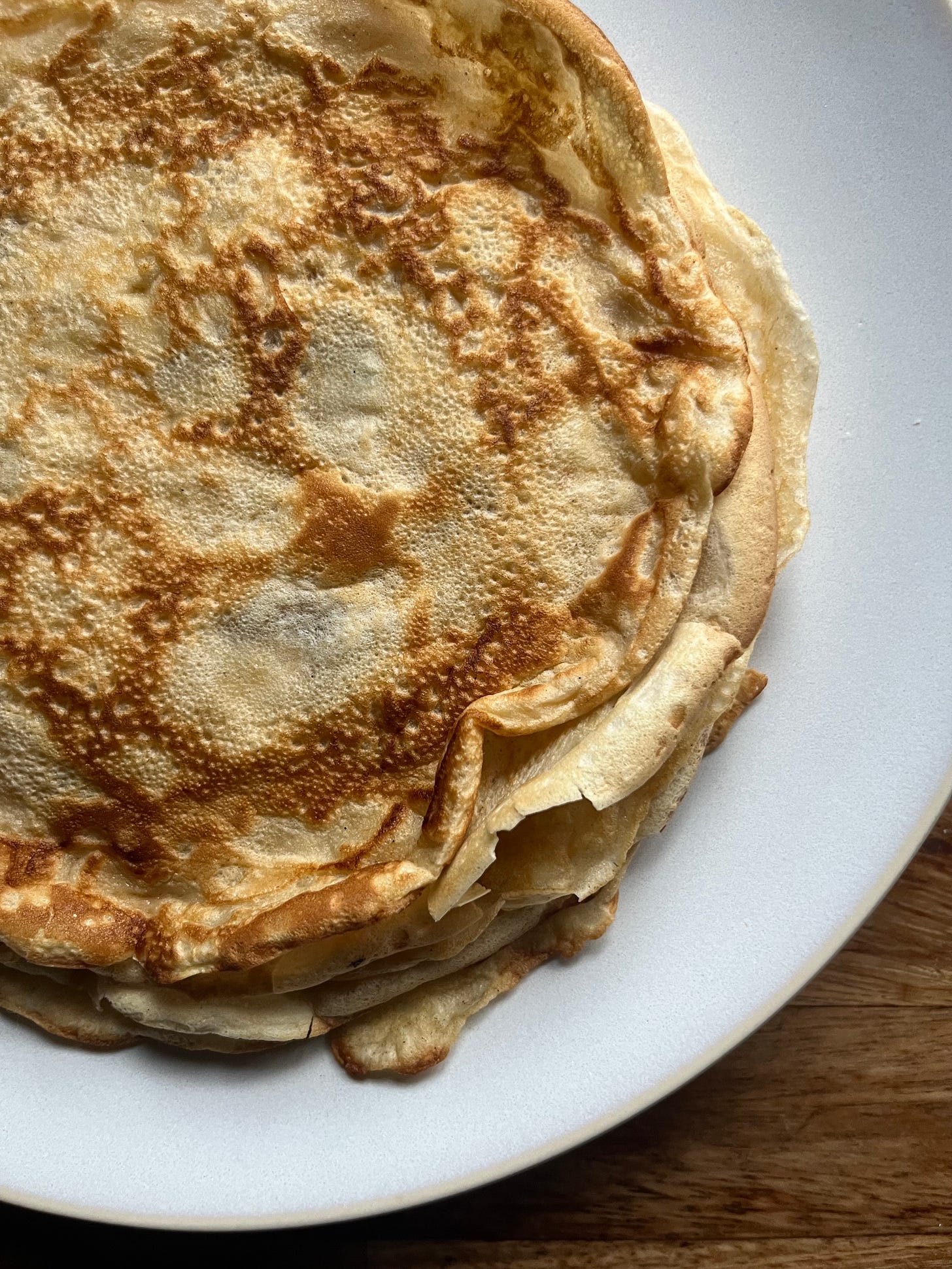

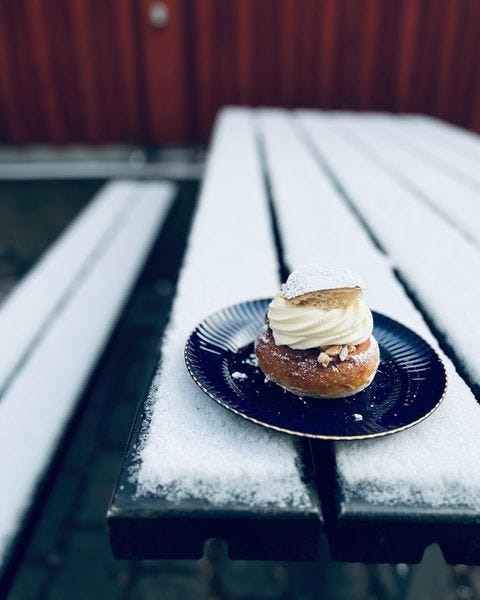
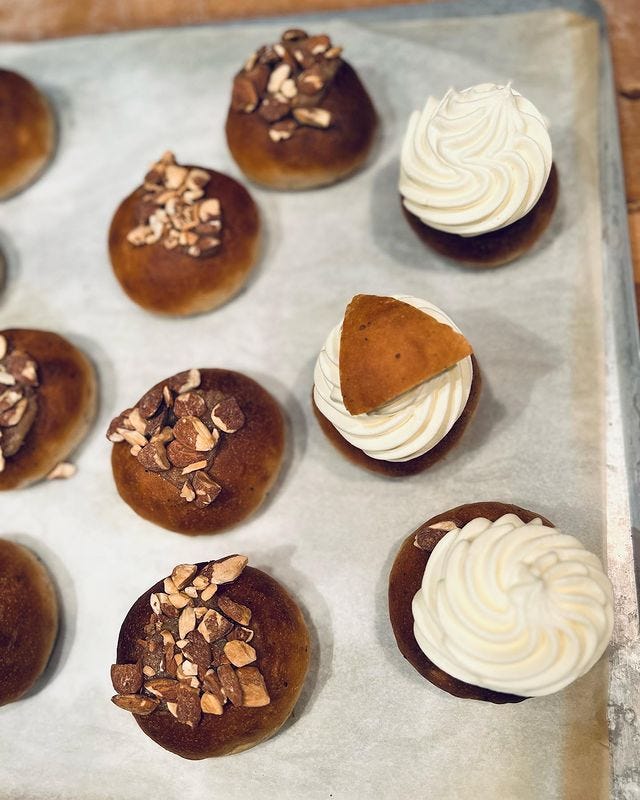
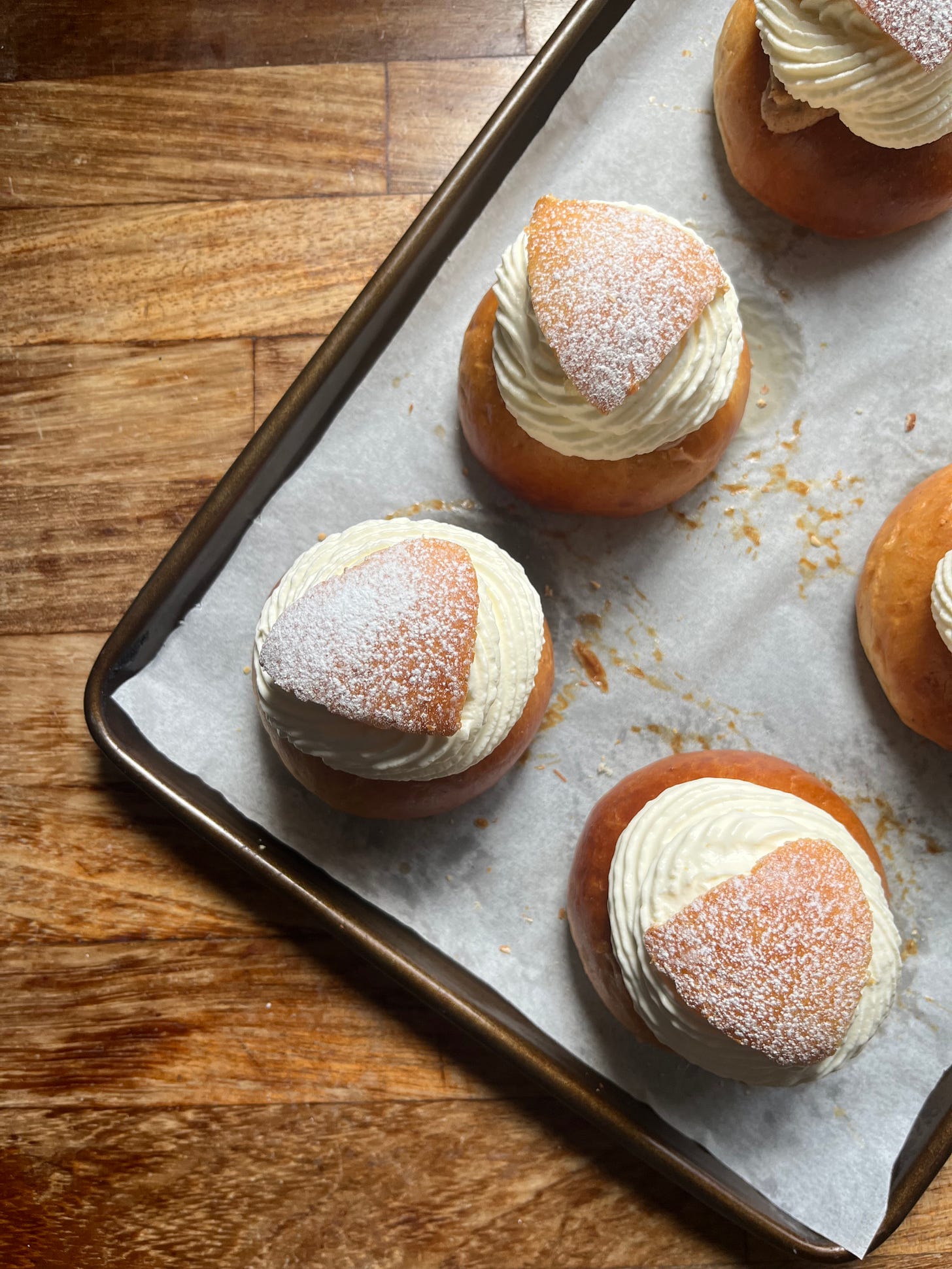
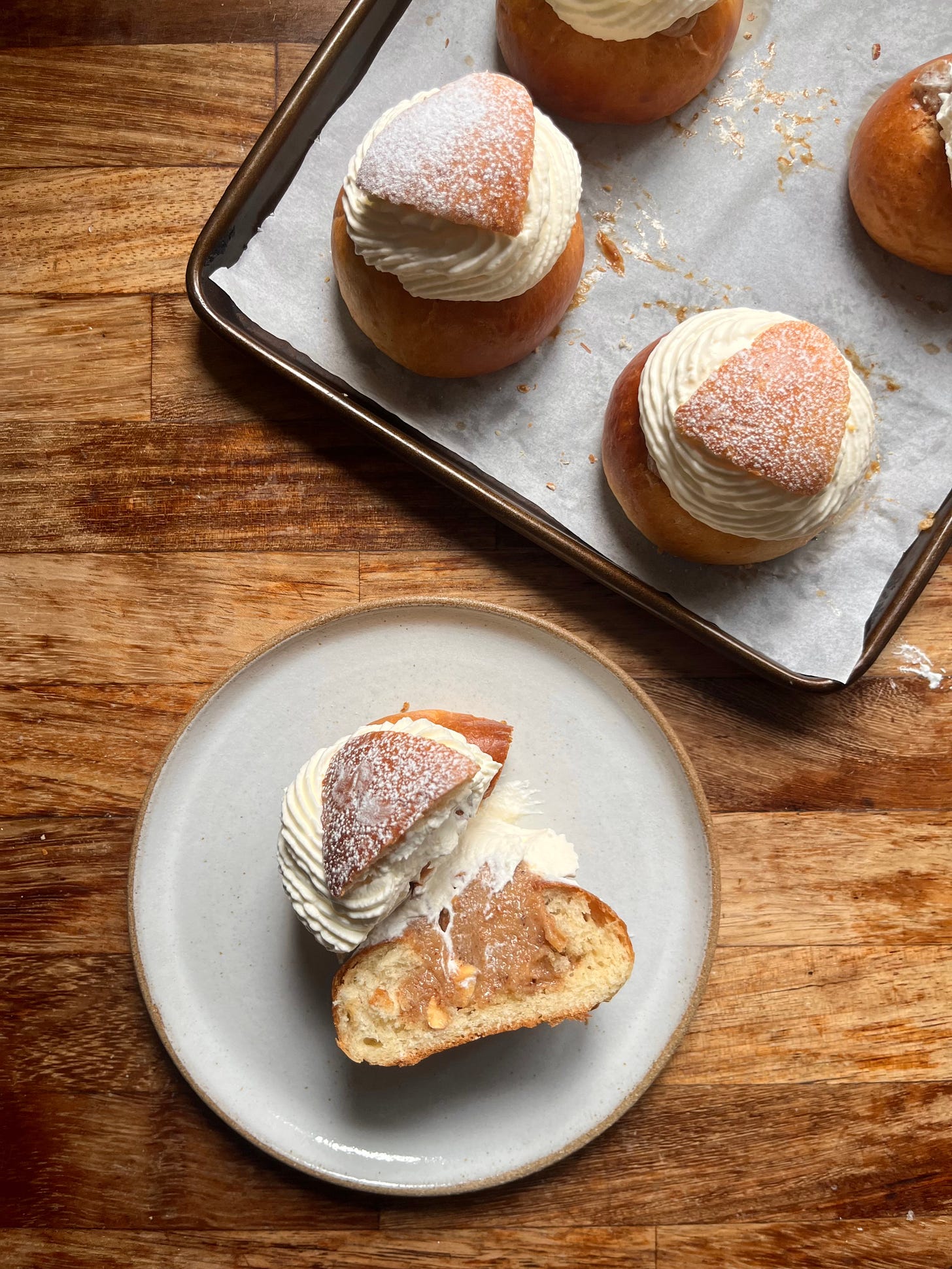

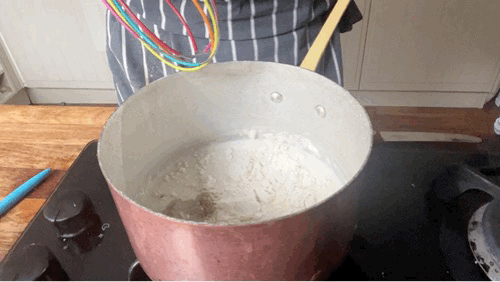
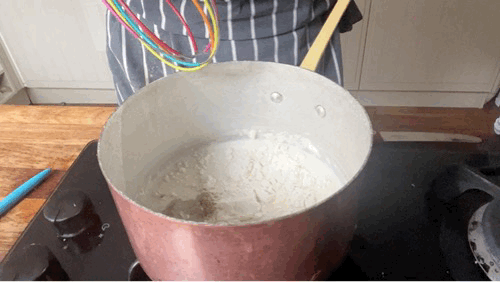

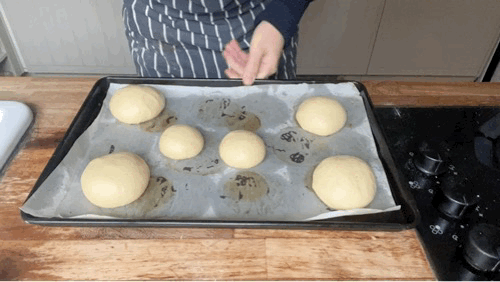



Can't wait to make these - thanks Nicola ❤️
Always wanted to make these! Thanks for the deep dive into these amazing buns. Could almonds be substituted for another nut like hazelnuts?